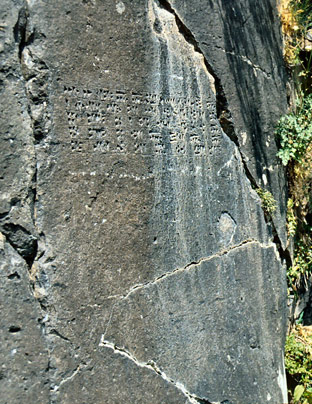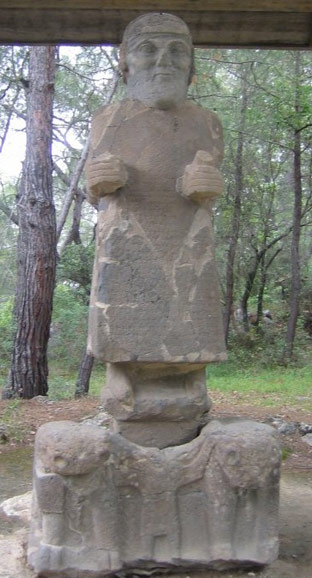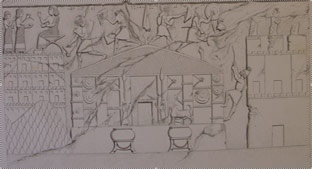Urartu, Assyria's northern archenemy
The political history of the 8th century BC was shaped by Assyria's prolonged conflict with Urartu, a kingdom encompassing the mountainous area between and around the three lakes of Van (in eastern Turkey), Urmiya (in north-western Iran) and Sevan (in Armenia) and the valley of the Murat Su up to its confluence with the main branch of the Euphrates.
Two battles at Arpad, 754 and 743 BC

This example of an Urartian rock inscription from the vicinity of Marmashen in Armenia dates to the reign of Argišti, son of Menua, in the early 8th century BC and marks a victory over the local ruler Eriahi: "Thanks to the greatness of the god Haldi, Argišti says: I conquered Eriahi's country, I conquered the city of Irdaniu, (reaching) as far as the country of Išqigulu". Photo by Stephan Kroll.
In 743 BC, just after Tiglatpileser III (744-727 BC) had taken the Assyrian throne by force, he defeated the Urartian army in a battle in the northern Syrian kingdom of Arpad and pursued it back to Turušpa via Kummuhhu (Commagene), where another battle took place. This was the first, and remained the only, time that Assyrian troops ever reached that Urartian capital. Turušpa, situated on a rock high above Lake Van, proved impregnable but the siege had high symbolic significance and marked a change in the balance of power, heralding Assyria's renewed supremacy over the Middle East.
In the preceding decades, Assyria had steadily lost its former influence in northern Syria and southern Anatolia to Urartu, culminating in a direct battle between the Assyrian and Urartian armies in the territory of the kingdom of Arpad in 754 BC. As his royal inscriptions proudly proclaim, the Urartian king, Sarduri son of Argišti, defeated the forces of Aššur-nerari V (754-745 BC), striking a hard blow against Assyria's political standing in a region which had formerly accepted the Assyrian king as overlord and arbiter in all border conflicts. After Tiglatpileser's victory in 743 BC on the very same battlefield, the old status quo was not re-established as the former vassals were now clearly considered untrustworthy. Instead, they were turned into Assyrian provinces, one after another, and the local rulers replaced with loyal officials appointed directly by the Assyrian king. This first wave of expansion beyond Assyria's traditional boundaries marks the beginning of Assyria's Empire period.
The birth of the Assyrian Empire

Tell Rifa'at, the site of the ancient city of Arpad, capital of the kingdom of the same name, as seen in 1960. Photo from M. V. Seton Williams, Iraq 23 (1961), pl. XXXIIIa.
In the years following the second battle of Arpad, the northern Syrian kingdoms of Arpad, Hamat and Unqu, now without Urartian support to assist them, were invaded and annexed as Assyrian provinces. Sometime after the Urartian campaign, one of Tiglatpileser's officials urged his king to re-attempt the capture of Turušpa in order to achieve immortal fame but the ruler did not follow this hawkish suggestion and seems instead to have avoided any direct confrontation with Urartu for the remainder of his rule.
In the light of ongoing Assyrian expansion in the west, the surviving kingdoms in the region, such as Que (Cilicia), are known to have sought Urartu's protection. However, these attempts seem to have been unsuccessful and, in some cases, the diplomatic delegations never even reached their destination. Hence, following the annexation of Que as an Assyrian province just prior to or at the very beginning of the reign of Sargon II (721-705 BC), the province's new Assyrian governor was able to report to his king that "A messenger of Mita of Muški (i.e. Midas the Phrygian) has come to me, bringing me fourteen men of Que whom (their king) Warikas had sent to Urartu as an embassy", to which the king replies, "This is extremely good! My gods Aššur, Šamaš, Bel and Nabû have now taken action, and without a battle or anything, the man of Muški has given us his word and become our ally!" (SAA 1 1).
Wars by proxy

The storm god of Que: monumental statue of the god standing on his chariot, with an inscription in the Phoenician alphabetic script (mid-8th century BC). Found at Azatiwadaya (mod. Karatepe) and now on display in the Karatepe-Arslantaş National Park.
But while Urartu was keeping quiet on the western front, it now concentrated its military presence in north-western Iran and attempted to supplant Assyria as the overlord of its regional vassal kingdoms, such as Mannea and Zikirtu. This resulted in a sustained war from 719 to 714 BC, which was again fought neither on Assyrian nor on Urartian territory but instead by proxy in Mannea, Zikurtu and Muṣaṣir, resulting in the looting of that city's ancient temple in 714 BC. While Assyria was able to gain the upper hand in this conflict, it resulted only in a shift of the theatre of war back to the Turkish-Syrian border.

The Assyrian sack of the city of Muṣaṣir and of its temple dedicated to the god Haldi, as shown on a relief from the wall decoration of Sargon's palace in Dur-Šarruken (room 13, slab 4). Drawing from P.-É. Botta and E. Flandin, Monument de Ninive, vol. 2, Paris 1850, pl. 141. View large image.
There, Muwatalli, king of Kummuhhu (Commagene), had stopped paying tribute to the Assyrians and had instead chosen to become an Urartian vassal after his country had been a loyal Assyrian vassal for at least a century. In the light of the Assyrian annexation of the neighbouring kingdoms of Carchemish (in 717 BC) and Marqasu (in 711 BC), this may have seemed the only way to preserve his country's independence but, instead, it proved its death warrant: Kummuhhu was conquered in 709 BC and integrated into Assyria, which for the first time shared a direct border with Urartu. Because of this sensitive geopolitical position, the new province was not placed under the authority of an ordinary governor but was handed over to one of the highest military officials in the Assyrian Empire, the Commander-in-Chief of the Left (turtānu šumēlu), resurrecting a practice employed under Shalmaneser III (858-824 BC) who had appointed the highest military commanders over Assyria's border regions in areas where major conflict was to be expected and major troop availability was necessary.
The Cimmerian threat
We may assume that Urartu sent at least some troops south of its border with Kummuhhu during the war of 709 BC, but the sources are silent in this regard. It was at this time that Urartu's northern border, hitherto seemingly out of harm's way, was seriously threatened by the incursions of Cimmerian horse nomads who had entered Anatolia from the Caucasus region, as Assyrian intelligence reports relay to the king. A generation later, the Cimmerians had established a permanent presence in Iran and, shortly after, they are also found to be active in western Anatolia, indicating that Urartu's attempts to halt their progress had ultimately failed.
However, the Urartian pre-occupation with the Cimmerians in the north of the kingdom may be a key factor in explaining why the years of active military conflict between Assyria and Urartu came to an end in the late 8th century BC, without any formal peace treaty being concluded as far as we know.
Further reading:
Deller, 'Ausgewählte neuassyrische Briefe betreffend Urarṭu', 1984.
Dubovský, 'Conquest and reconquest of Muṣaṣir', 2006.
Lanfranchi, 'A happy son of the king of Assyria', 2009.
Radner, 'Provinz: Assyrien', 2006.
Radner, 'Between a Rock and a Hard Place', 2012.
Content last modified: 20 Jul 2021.
Karen Radner
Karen Radner, 'Urartu, Assyria's northern archenemy', Assyrian Empire Builders, University College London, 2021 [http://oracc.museum.upenn.edu/saao/aebp/essentials/countries/urartu/]